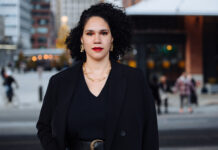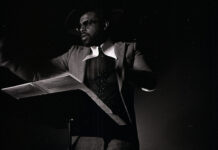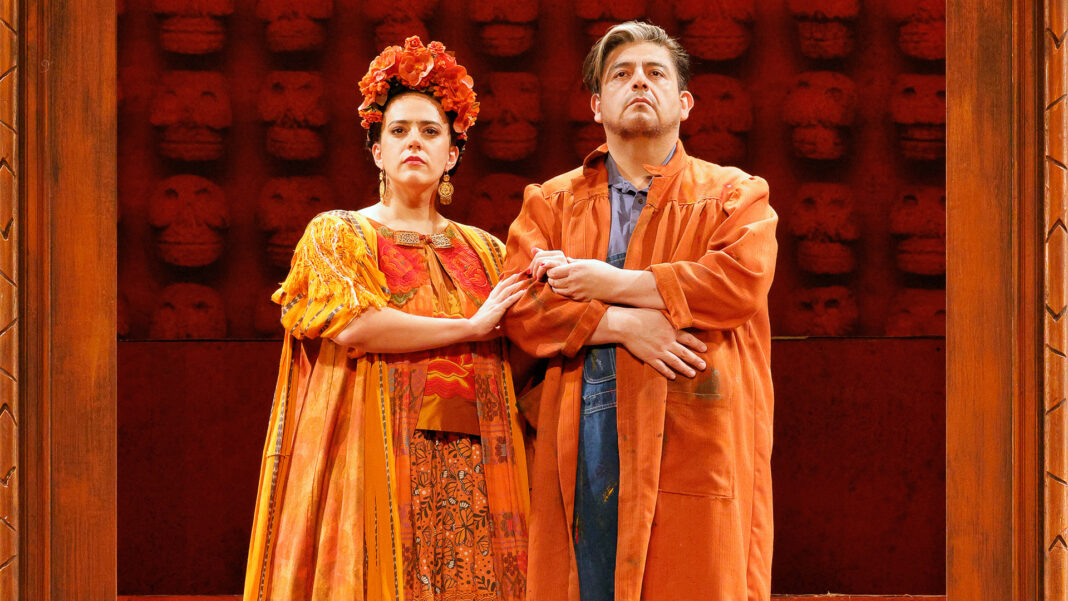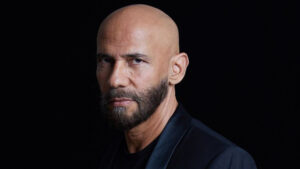
Playwright Nilo Cruz and composer Gabriela Lena Frank have collaborated so many times it would be easy to assume that their 2022 opera, El Ultimo Sueño de Frida y Diego (The Last Dream of Frida and Diego), would be their most recent work.
In reality it is the work that first brought them together more than a dozen years ago. El Ultimo Sueño had its world premiere last October at San Diego Opera. In June of this year it was performed at San Francisco Opera. This Saturday it will open at LA Opera where it runs through December 9th.
Cruz and Frank’s opera finds Frida Kahlo (Daniela Mack) having already passed away. Diego Rivera (Alfredo Daza) is on the cusp of passing away but wants his beloved Frida to come back from the underworld to help him in his transition to the afterlife. She’s very reluctant to do so given the pain he caused her in her life. The opera is set around Dia de Muertos (Day of the Dead). Think of the opera as the Orpheus and Eurydice myth reversed with a healthy dash of the animated film Coco.
Cuban-born Cruz is best-known as a playwright. In 2003 he won the Pulitzer Prize for drama for his play Anna in the Tropics. His other works include Dancing on Her Knees; Two Sisters and a Piano; Hortensia and the Museum of Dreams; Lorca in a Green Dress and A Very Old Man with Enormous Wings. His collaborations with Frank include The Conquest Requiem and The Santos Oratorio and the text of orchestral songs, La Centinela y la paloma.
Earlier this week I spoke with Cruz who was at his home in Florida. During our conversation we talked about the challenges of breathing new life into Frida Kahlo and Diego Rivera given how much has already been written about them; the new-found politics that are represented by a character they created for the opera and about the nature of art and creativity.
What follows are excerpts from our conversation that have been edited for length and clarity.
Q: Is there a difference in the way Cuba, or Cubans in particular, feel about Diego Rivera and Frida Kahlo that maybe is different than how they are perceived in the States or elsewhere?
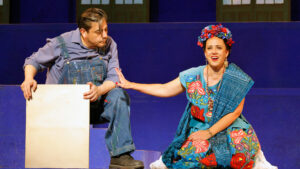
It’s hard for me to know because I left Cuba when I was so young. I left when I was ten years old. But they’re great revolutionaries and they were socialists. A few writers in Cuba have written about them in the theater. I believe they’re embraced by by the island, by people on the island, of course. But who doesn’t love them? Who cares, you know, about their political affinities? They’re just people you want to love because of the art they produced and what they give to the world.
Underneath the acrimony and history that exists between Frida and Diego in the opera, this is truly a love story. What was key for you in realizing the best way to dramatize that love story?
I believe it was when I read that at the end of his life Diego Rivera requested his ashes to be reunited with Frida’s ashes. Talk about a great love story. He wants to be in the in afterworld with Frida. That was so touching when I read that I thought this needs to be a love story and it needs to be a love story in which the Day of the Dead is involved.
They were soulmates. They were kindred spirits. Even though they had relationships with other men and women, they really loved each other. They caused each other a lot of pain. Unfortunately other things happened along the way, but they should have been together from the beginning and to the end. But human beings are full of faults and this is what makes the story so compelling in many ways for an opera and for the theater.
What was most important to you and Gabriela to make this a different way of telling this story or revealing who these people were as you wanted to depict them?
When Gabriela approached me with the subject matter, I had a little bit of resistance at the beginning because there was so much out there about them. But when I sat down and listened to her music, she had a piece that had to do with The Day of the Dead. I said to her, let’s not write a biopic or a biographical opera about them. Let’s go in this direction because they both adored that holiday. I thought this is the way to enter this opera. When I was remembering Orpheus, the operas, and the beautiful myth of Orpheus and Eurydice, I thought let’s do something similar to that.
There have been countless Orpheus operas and most recently there’s Matthew Aucoin‘s opera, Eurydice, based on the play of the same name that looks at this story from her point of view. The musical Hadestown deals with that myth. Do you think we’re living in a time where we all clamor for really great love stories, even if they don’t end up together?
I think that we have become so cynical that we need something else in order to believe in love again. That’s what we do in this opera. That’s what I’m always doing with my work. Whether the plays are political, there’s always a love story there in between the lines and the lives of the characters.
You’ve collaborated many times with Gabriela well before this particular opera. Of all the collaborations that you’ve done with her, what makes this particular work unique for you?

This is the work that brought us together. Unfortunately it took years for us to work on the opera. In the meantime, we started to work on other things and those projects became preparations for us to work on this large canvas. We were always dialoging, even we were doing other pieces together, about Frida and Diego. It allowed me to become a better librettist. It allowed Gabriela to explore her music and her talents as a composer. So I think we were always preparing for this.
At the time of the opera’s world premiere in San Diego, director Lorena Maza told KPBS that as a creative team you asked yourselves “what are Diego and Frida for us now.” Who are they for you today as opposed to maybe who they were before you started this project?
Oh, they’re still the same for me. I feel enormous amount of love for the two of them. I think Frida and Diego don’t just belong to Mexico, they belong to the world. So for me nothing has changed. If anything it is more the responsibility of exposing them to more people, even though they don’t need that exposure. They were great artists who gave great treasures to the world. For me it was just honoring them, honoring their love for each other, honoring their beliefs in life and what they gave us in terms of their paintings.
There’s only one true duet between the two of them in the opera. Was that an intentional part of the structure that this moment became so emotional that this was the only time where these two would sing together?
We thought that politics would bring them together. Especially when they started to look at the world around them. That, in some ways, made them reflect on some of the things that they loved in life. They wanted the universe to change. They wanted things to change in Mexico and all over the world. That, of course, caused us to write a a duet. It’s really the moment in which they almost come close to each other, but somehow they don’t.
Do you think that passion was equal to the passion they had for each other?
I think that passion, their love for each other, art and politics were all intertwined when it came to Frida and Diego.
Tell me about the creation of the characters of Katrina (Ana María Martínez) and Leonardo (Key’mon W. Murrah)?
Katrina is the keeper of the dead. She’s the gatekeeper. She was very helpful to navigate between the two worlds. Then Leonardo, who possesses the male and the female in the way he presents himself in life, I thought would be very interesting to do. He’s an artist luring Frida back to the world. I didn’t think that Frida would come back to the world just because of her passion for Diego. I think it needed to be something more, and it had to do with her passion for art.
It’s a very consuming art form. I think that all artists are this way. It’s not the time that we spend working on our art, but all the time we spend away from it. We’re also thinking about it. For her, because she was such a passionate painter, I think there needed to be another artist to convince her to come back to the world. Of course, Katrina was sort of the antagonist in some ways because we needed an antagonist as well. These were the things that were circling me when I was writing the libretto.
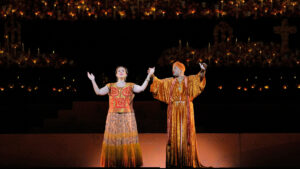
When you started working on this opera you probably didn’t think that the idea of a drag character would become a political statement. But given everything that’s going on in the United States has Leonardo turned out to be a political character? And when something like that happens to a work that you’ve created, where it takes on a different meaning now than you intended, how does that land with you as an artist?
That’s the beauty of art: that it continues to grow throughout time. When we saw it in San Diego and later in San Francisco, I started to see that character in a different light. With everything that’s happened, what was happening, what is still happening, especially since I’m in Florida, I thought, how wonderful that we chose this character that not only has a role to play in this world of Frida and Diego, but also for our modern times as well. Being such a beautiful character, such a generous human being who is passionate about life and the world. Even though he’s probably, or they, I should say, gone through difficult times, there’s still this love for the world.
Stephen Sondheim and James Lapine brought the interior and the exterior world of an artist’s life on stage beautifully in Sunday in the Park with George. John Logan did the same thing with Rothko in his play, Red. What are the inherent challenges for any writer who is also an artist to bring both an artist’s exterior and interior worlds to vibrant life on stage?
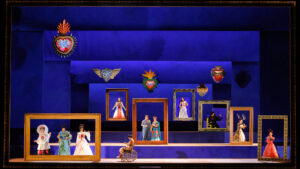
Sunday in the Park with George was very inspirational for me. If you think about it my source of inspiration’s really the paintings by both Frida and Diego. Usually those who write about artists, especially if you’re writing an opera or you’re writing a book – unless you’re writing a non-fiction book – I think one needs to tap not only into the the biography of the artist, but you also need to tap into your own imagination and your own take of what the role of the artist is in the world. I think art can save and I think art can offer possibilities.
Is it important for you to see yourself in the people that you’re writing about?
I think there’s always something of the personal in my work. There has to be somehow. I think plays are like children. They are pieces that we create, and, of course, they inherit some of our sensibilities. I don’t mind that at all.
There’s a real economy of words in your libretto. Late in the opera Diego sings “To paint is to remember” and Frida responds “To paint is to relieve the hurt.” How would you describe what the act of creation is for you?
I think it’s a struggle. It’s a struggle to find the word. Sometimes writing is about not finding the word, but what you encounter in between your search for the word. So it is a struggle. It’s almost nightmarish sometimes, too, because you ask more of yourself and the piece asks more of you. You don’t want to repeat yourself. And if you repeat yourself, you try to repeat yourself in a different way or with different colors. So I think the art form is very, very demanding. But more than anything, that it’s not to impose yourself on the piece, but to learn from the piece and what the piece is asking of you as an artist. To be in that state of mind and to be open to it.
Main Photo: Daniela Mack and Alfredo Daza in El Ultimo Sueño de Frida y Diego by Gabriela Lena Frank and Nilo Cruz at LA Opera (Photo by Cory Weaver/Courtesy LA Opera)


